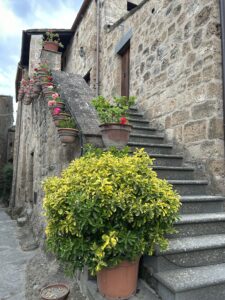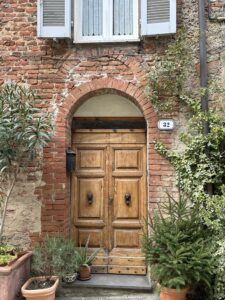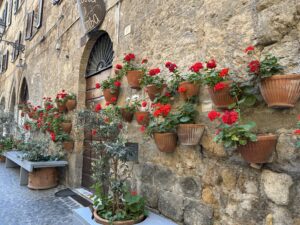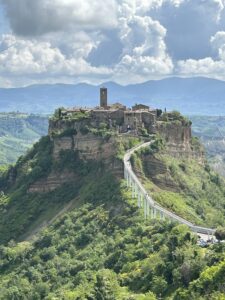“Location, location, location!”
Anyone who’s ever bought a house learns this mantra right from the start as a significant priority, and it makes no difference if you’re in Tennessee, the Pacific Northwest, or somewhere in the historic backroads of Italy.
If Dan and I had continued to search for another year or two, we still could never have found a more perfect location for us than we did for our Italian house in Citta della Pieve. Tucked neatly into the historic center of a medieval hilltop city– walking distance to shops, cafes, restaurants, bank, pharmacy, markets– surrounded by a stunningly beautiful and lush green Umbrian landscape, our home is a mere 12 minute drive to the Chiusi (pronounced “Q-Z”) train station with direct lines to Rome, Florence, and multiple renowned Tuscan or Umbrian cities like Arezzo, Cortona, Orvieto. There are easy transfers by train to places like Siena. Just outside the city wall, there’s a car rental dealership a mere 5 minute walk from our house, and by car, we have relatively quick and easy access to so many more places– Assisi, Montepulciano, Castiglione del Laga, Civita di Bagnoregio… and oh so many more. Our location couldn’t possibly have been better!
With a steady flow of friends who have come to stay with us in our home in Italy, we’ve found ourselves revisiting many of these places multiple times as we introduce them to the history and stunning beauty of Umbria and Tuscany.
Because of the narrow, winding back roads, the renowned tourist town of Orvieto is a leisurely 35-40 minute drive from our house, but it’s only the next train stop from the Chiusi station going south toward Rome. The Orvieto train station sits literally at the base of the gigantic hill– the city is so easy to access, which is probably why it’s become a significant tourist town. It first took my breath away on my original glimpse of this magnificent hilltop city in 2012. Built 2,500 years ago (I’m not kidding), Orvieto was historically a meeting place for the Etruscans. It stands majestically at the top of magnificent sheer cliffs. For pedestrians, it’s accessible on one side by a funicular that rides very steeply upward, or for a more modern approach, a series of long underground escalators from a parking garage on the other.
Unquestionably, the focal point of the town is the gigantic duomo (cathedral) that dominates the piazza, surrounded by colorful ceramics shops, shaded outdoor cafes, amazing lookouts over the vast valley…there’s so much to absorb! In 2017, tucked under umbrellas, we wandered its quiet, rainy streets with our kids and their spouses. In 2019, we celebrated our mutual 45th anniversaries there with two other couples as well as other friend, and more recently we explored the ancient city with our two oldest adult grandkids. Dan and I stayed in a vacation rental there once for several days, truly savoring the city, and now– so close to where we live in Italy– we frequently explore the stunning city with visiting guests, or even just by ourselves when we have the urge to spend an afternoon wandering.
Civita di Bagnoregio is only a half hour drive by car from Orvieto and it’s probably my favorite place on earth. I’m not exaggerating. Built before 725 BC, the small town was virtually disappearing as erosion cut away the edges of the plateau it sits on, tumbling the outer edges of the city buildings into the canyon below. The population was becoming sparse until travel guide Rick Steves discovered it, wrote about it, and consequently revived the dying town with tourism. It’s now thriving, a highly popular site for visitors, understandably!
Civita di Bagnoregio (“Little City by Bagnoregio”) is accessible only by a very steep pedestrian bridge that spans a deep canyon, linking the ancient town with neighboring Bagnoregio. It was a very quiet, relatively unknown place when we first visited with friends in 2012, in its very early days of tourism. Mesmerized by the sensation of stepping so far back in time in this incredible medieval place, on that trip we inquired and were thrilled to find 2 vacant rooms to rent (the most primitive place I’ve ever stayed in), and like giddy little kids, we savored our spontaneous overnight stay.
A sudden rain shower poured down on us, soaking the only clothes we had, and when it cleared, a full rainbow spanned the gigantic canyon below. It was surreal! An elderly Italian man walked past me and clearly took note of my incredulous amazement. His hand swept across the air in an arc as he traced the path of the bow and he said, “Arcobaleno!” And I learned my first Italian word.
Alma Civita is a restaurant there that’s been family run for 400 years. The current owners, Maurizio and his sister Alessandra prepared a delicious meal for us during that initial visit in 2012, and we’ve returned so many times since then with a variety of friends– including our kids and their spouses– to savor his gourmet feasts. Maurizio has become a friend that we’re always so happy to see again and again.
Every medieval hilltop city we’ve ever been to has been another startling surprise– like opening an unexpected gift. Tuscany and Umbria are rich with authentic history and indescribable beauty.
Every part of Italy is surprisingly unique and beautiful in its own way, but I’ve lost part of my heart in Umbria. We keep going back to try to find it. I haven’t had success yet, but I know for sure what we have found…Location, location, location!





Comments
Powered by Facebook Comments